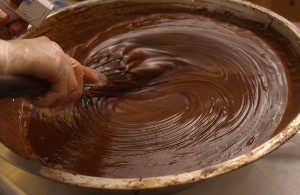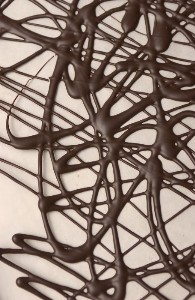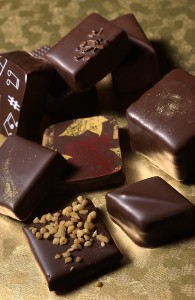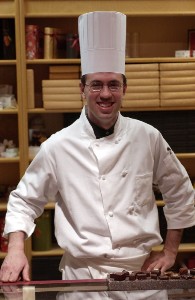Special Feature: Products Sally Recommends
Chocolate: Health Food or Health Fad?
“It’s in the interest of everyone else’s health that I eat chocolate.” ----my sister Jocelyn
 We’ve all seen the study excerpts regarding chocolate and antioxidants/heart health or chocolate and reduced blood pressure. So how about it? Is chocolate the next great health food? I can answer that in a single word: no. And anyone who tells you otherwise is trying to sell you something---most likely, something chocolate.
We’ve all seen the study excerpts regarding chocolate and antioxidants/heart health or chocolate and reduced blood pressure. So how about it? Is chocolate the next great health food? I can answer that in a single word: no. And anyone who tells you otherwise is trying to sell you something---most likely, something chocolate.
Before you lunge at me with the nearest pointy garden implement, I’d like to be allowed to explain myself. I’ve been writing about chocolate for more than 8 years now, and I’ve always adored it. Unless I’m very, very, very sick, I eat chocolate every single day. It should be obvious from this that I don’t consider chocolate to be horribly bad for people; it just doesn’t qualify as a health food. Let’s look at some evidence for that…
We’ll start with cocoa, the basic component of all real chocolate. Cocoa does have some nutrient value, especially for vitamins B1, B2, iron, and magnesium. It also contains some fiber. But people generally don’t ingest significant amounts of cocoa by itself; it’s usually mixed with sugar, fat, and flavorings as chocolate. If you eat a lot of chocolate, especially darker chocolate, which has a higher cocoa content, you’ll get some of these nutritional benefits, but you’ll also ingest a lot of calories, fat, and sugar along with them.
 Cocoa is high in antioxidants, especially flavanols, a type of flavanoid. The American Heart Association website cites a study conducted in Italy on 20 people (10 men and 10 women). In a 6 week timeframe, the participants who ate a daily ration of 100 grams (about 3.5 ounces) of dark chocolate high in flavanoids experienced a statistically significant decrease in blood pressure (both systolic and diastolic) and a significant reduction in several measures of insulin resistance compared to a control group who ate the same amount of white chocolate daily (white chocolate, which is not real chocolate, contains no cocoa). Well, great. But only 20 people took part in the study, and they were monitored for only 6 weeks. I’d prefer to see research with a far greater number of subjects who were monitored for a much longer time period. Even the author of the study, one Jeffrey B. Blumberg, Ph D., warned, “This study is not about eating more chocolate”. Also, flavanoid-high chocolate tends to be bittersweet; milk chocolate, still more widely eaten in the US, at least, has far less in the way of antioxidants because it contains a lower percentage of cocoa.
Cocoa is high in antioxidants, especially flavanols, a type of flavanoid. The American Heart Association website cites a study conducted in Italy on 20 people (10 men and 10 women). In a 6 week timeframe, the participants who ate a daily ration of 100 grams (about 3.5 ounces) of dark chocolate high in flavanoids experienced a statistically significant decrease in blood pressure (both systolic and diastolic) and a significant reduction in several measures of insulin resistance compared to a control group who ate the same amount of white chocolate daily (white chocolate, which is not real chocolate, contains no cocoa). Well, great. But only 20 people took part in the study, and they were monitored for only 6 weeks. I’d prefer to see research with a far greater number of subjects who were monitored for a much longer time period. Even the author of the study, one Jeffrey B. Blumberg, Ph D., warned, “This study is not about eating more chocolate”. Also, flavanoid-high chocolate tends to be bittersweet; milk chocolate, still more widely eaten in the US, at least, has far less in the way of antioxidants because it contains a lower percentage of cocoa.
Cocoa is also far from the sole source of antioxidants. Have you heard about the oxygen radical absorbance capacity (ORAC) numbers? They’re popular in advertising these days. The ORAC measurement assigned to a food indicates total level of antioxidants; the higher the number, the greater quantity of antioxidants present. 100 grams of dark chocolate has an ORAC number of thirteen thousand, one hundred twenty (13,120), which is astonishingly high among commonly-eaten foods. Even 100 grams of milk chocolate has an impressive ORAC measurement of 6,740. Compare those to some so-called antioxidant “superfoods” such as raspberries (100 grams has an ORAC number of 1,220) or blueberries (2,400) or even prunes (5,770). But there are two catches here. First, antioxidants are only part of the picture; a food’s entire nutritional profile should be considered before it’s judged healthy or otherwise. Take those 100 grams of raspberries. The USDA tells you that that quantity contains 52 calories and 6.5 grams of fiber, as well as 0.65 grams of fat (none of it saturated) and 4.42 grams of total sugars. Raspberries are also a very good source of Vitamin C and contain some smaller amounts of other vitamins and minerals, especially folate and potassium. On the other hand, those 100 grams of dark chocolate will generally have between 475 and 525 calories, with somewhere around 35 grams of fat, 21 of it saturated. You’ll get about 11 grams of fiber with that, and somewhere between 38 and 46 grams of sugars. There’s a decent quantity of Vitamin E and potassium in that mix. (Milk chocolate, of course, has more calories, more sugars, less fiber, and less nutrition content overall.) There’s not much comparison when thinking about nutritional bang for the calorie buck, is there? Something else interesting: on a per calorie basis, dark chocolate’s ORAC reading is 24. But the raspberry’s ORAC number per calorie is 25. Blueberries have an ORAC number of an amazing 43 per calorie, and some fruits and vegetables measure even higher than that.
What’s the second catch? The ORAC number reflects both a substance’s overall antioxidant capacity and the time it takes to react as an antioxidant----in a test tube. Does this work similarly in the human system? No one knows. Different antioxidants appear to work in varying parts of the body, too, so merely getting a large “hit” of flavanols may not protect certain areas of your system against oxidation. As far as levels of antioxidants, it seems that the human system is capable of handling or processing a finite amount in any given time period. Much like water-soluble vitamins, any excess is simply excreted, so a higher number in a food isn’t always better.
I’m not knocking the potential of antioxidants in human health; I think it’s very real. But so little is known about antioxidants at this point that there isn’t much more to them than their potential. Combine that fact with the nutritional profile of any type of chocolate, and it becomes obvious even to a devoted consumer like myself that chocolate isn’t a health food, period. And I still think the best way to get antioxidants into your diet is to consume a variety of brightly-colored fruits and vegetables and whole-grain foods.
Does this mean you have to stop eating chocolate? I hope not, or I’m in serious trouble! Most healthy people don’t have to suppress those chocolate cravings. Eat a sensible diet, get your exercise and sleep, maintain a healthy weight, and enjoy your chocolate---in moderation. Maybe someday someone will invent a chocolate that really is a health food. Until then, regard chocolate as what it is: a delicious indulgence.
![]()
Recipe of the Month:
Modestly Chocolate Chiffon Cake
As the name implies, this is a dessert with a modest chocolate content; a mere three ounces of grated chocolate speckles a tall and handsome, citrus-perfumed chiffon cake. I like to eat this delicate creation plain, accompanied by tea or milk, though you can sift a bit of confectioners’ sugar over the top just before serving.
You’ll need an electric stand mixer or a sturdy hand-held mixer to make this, in addition to a 10 by 4 inch, two-piece tube pan (in a two-piece tube pan, the tube and bottom are one piece and the sides are one piece). Even if the pan has “feet”, you’ll need a sturdy, empty bottle from which to suspend the cake to cool it (I use a clean, empty wine bottle). Yes, it is nerve wracking to turn a freshly-baked, hot cake upside down onto the neck of a bottle, but I’ve never yet had one fall out of the pan! The method really works.
The bowl and beater(s) you choose for beating your whites must be perfectly clean and grease-free (do not use a plastic bowl!). Separate your eggs when they are just out of the fridge, but remember that the volume of the whites will be far greater when beaten if they’re at room temperature.
6 eggs, graded “large” separated, plus 2 additional egg whites from eggs graded “large”
2-1/2 cups sifted cake flour
1-1/2 cups plus 2 Tbsp. granulated sugar, divided
3-1/2 tsp. baking powder
Large pinch of salt
3/4 cup water
1/2 cup light vegetable oil, such as corn or safflower
2 tsp. vanilla
Grated zest 2 oranges AND 2 lemons
1/2 tsp. cream of tartar
3 ounces semisweet chocolate, finely grated
At least an hour before you want to bake, remove eggs from the fridge. Separate them, placing the whites (including the two additional whites) into the large bowl of an electric mixer and the yolks into any small bowl. Cover both bowls lightly with plastic wrap and allow to stand until whites are at room temperature or very slightly warmer.
When ready to bake, adjust oven rack so it is one-third of the way up from the bottom of the oven. Assemble a two-piece, absolutely clean, 10 by 4 inch tall tube pan; do not grease or line the pan. Have ready a clean, empty, sturdy glass bottle with a relatively tall neck; an empty wine or liqueur bottle (750 ml size) will do just fine. Preheat oven to 325 degrees F.
Into a large bowl, sift the flour, 3/4 cup of the sugar (reserve remainder), baking powder, and salt. All at once, add the water, oil, egg yolks, and vanilla. With sturdy, hand-held mixer or whisk, beat at low speed to moisten dry ingredients, then increase speed to medium and beat until batter is smooth (batter will be on the thin side). With a spoon or spatula, stir in the citrus rind until evenly distributed. Set aside.
With whisk beater fitted to electric stand mixer, beat whites at high speed until foamy and slightly increased in volume. Sprinkle on cream of tartar. Beat in at low speed, then increase speed to high again and beat until traces of beater marks are visible in whites. Add reserved 3/4 cup plus 2 Tbsp. sugar in 6 additions, beating in each addition at low speed until incorporated, then returning speed to high for 10 to 15 seconds. Beat this meringue until it is just before stiff peak stage. Remove bowl from mixer.
Pour about one-sixth of yolk batter into meringue. Using a large spatula, fold in not too thoroughly. Continue to add egg yolk batter to meringue in about 5 more additions, folding each in not too thoroughly. With last addition of batter, add grated chocolate. Fold this mixture until all batter is incorporated into meringue (check the bottom of the bowl to be sure, as sometimes the yolk batter likes to hide down there) and chocolate flecks are evenly distributed. Pour into tube pan and gently and quickly spread level.
Bake in preheated oven for 45 to 52 minutes. Cake should rise slightly above edge of pan and may develop deep cracks in top surface; top will not brown deeply. Cake is done when a toothpick inserted into center emerges with only a few moist crumbs still clinging to it; do not overbake. Remove to cooling rack.
Working quickly and WEARING POT HOLDERS, take a deep breath, then turn the cake upside down so that the neck of the sturdy bottle fits into the tube of the pan. Be sure not to press the bottom of the pan! The cake pan may be tilted on the neck of the bottle—OK. The top of the cake should be at least 10 inches or so off your work surface. Allow cake to cool undisturbed.
When cake is at room temperature, turn right side up, then very gently loosen from sides and tube of pan. Carefully push cake up through pan; the cake will emerge right side up and still attached to the tube portion of the pan. Gently loosen cake from bottom of tube portion, then turn upside down onto large serving plate. Cake may be served immediately or stored airtight at room temperature for up to three days (freeze for longer storage). To cut, use a large, very sharp, serrated knife and a sawing motion to cut cake into slices.
About 16 servings
© Stephanie Zonis provides the above information to anyone, but retains copyright on all text. This means that you may not: distribute the text to others without the express written permission of Stephanie Zonis; “mirror” or include this information on your own server or documents without my permission; modify or re-use the text on this system. You MAY: print copies of the information for your own personal use; store the files on your own computer for your personal use only; reference hypertext documents on this server from your own documents.
![]()
Chocolate Find:
Chocolate Springs Café
 Too often, people go for chocolates with a flashy appearance and are disappointed by flavor that is, at best, mediocre. But that doesn’t happen with the confections from Chocolate Springs Café. These chocolates are beautiful, but they are delicate and precise in their eye appeal. Best of all, you won’t be let down when you taste them. Joshua Needleman, founder and owner of this establishment, has obviously taken care to use good-quality ingredients, and you’re bound to find something you like in the variety of flavors he offers. I recommend the All-Niter (espresso and coffee in a dark chocolate ganache) or his Hazelnut Praline or Cocoa Truffle, but there are more adventurous combinations as well, such as Chai This, with a ganache interior flavored with tea, ginger, cardamom, cloves, and cinnamon. If you enjoy sharing pretty chocolates, give a box as a gift, and do bear in mind that wedding and party favors are something of a specialty of the house here. Chocolate Springs Café will mail-order their chocolates, and a convenient online ordering system is already in place.
Too often, people go for chocolates with a flashy appearance and are disappointed by flavor that is, at best, mediocre. But that doesn’t happen with the confections from Chocolate Springs Café. These chocolates are beautiful, but they are delicate and precise in their eye appeal. Best of all, you won’t be let down when you taste them. Joshua Needleman, founder and owner of this establishment, has obviously taken care to use good-quality ingredients, and you’re bound to find something you like in the variety of flavors he offers. I recommend the All-Niter (espresso and coffee in a dark chocolate ganache) or his Hazelnut Praline or Cocoa Truffle, but there are more adventurous combinations as well, such as Chai This, with a ganache interior flavored with tea, ginger, cardamom, cloves, and cinnamon. If you enjoy sharing pretty chocolates, give a box as a gift, and do bear in mind that wedding and party favors are something of a specialty of the house here. Chocolate Springs Café will mail-order their chocolates, and a convenient online ordering system is already in place.
 There’s more to this business, however. Chocolate Springs Café is an actual sit-down-and-eat spot, if you’re looking for dessert and coffee after a concert or for a break in the old routine some afternoon. The café is in Lenox, MA, near Tanglewood and the historic Lenox Village. In addition to their chocolates, they serve cakes and cheesecakes (which are not available through the mails but can be picked up if you live locally) as well as cookies, brownies, and biscotti (I’m told that this latter grouping is available via mail-order, but I haven’t tried any of them). There’s even hot chocolate for those chilly Northeast winter days. For more information, call the café at (413) 637-9820, or surf over to www.chocolatesprings.com. We should all have chocolate springs in our neighborhoods!
There’s more to this business, however. Chocolate Springs Café is an actual sit-down-and-eat spot, if you’re looking for dessert and coffee after a concert or for a break in the old routine some afternoon. The café is in Lenox, MA, near Tanglewood and the historic Lenox Village. In addition to their chocolates, they serve cakes and cheesecakes (which are not available through the mails but can be picked up if you live locally) as well as cookies, brownies, and biscotti (I’m told that this latter grouping is available via mail-order, but I haven’t tried any of them). There’s even hot chocolate for those chilly Northeast winter days. For more information, call the café at (413) 637-9820, or surf over to www.chocolatesprings.com. We should all have chocolate springs in our neighborhoods!
![]()
Stephanie (HandOverTheChocolate@comcast.net) has had a strong affinity for chocolate from a very early age. Family members claim that, as a child, she was able to hear chocolate being opened in the kitchen no matter where she was in the house. Stephanie was baking by the time she was 6 and ran a short-lived baking business out of her parents’ kitchen when she was in high school. She has a Master’s Degree in Foods from Virginia Tech but no formal training in cooking or baking. Consequently, she is a home cook, not a chef. Prior to beginning this column, she had written about chocolate for some 8 years.
Note: This information was accurate when it was published. Please be sure to confirm all rates and details directly with the businesses in question before making your plans.



